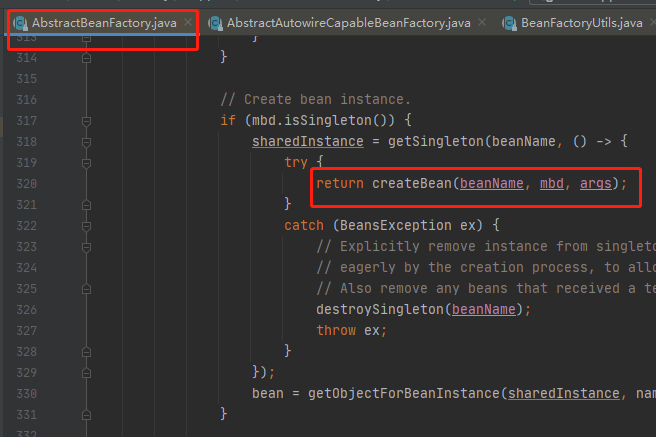在前面的两篇博文《一次性讲清楚spring中bean的生命周期之一:getSingleton方法》和《一次性讲清楚spring中bean的生命周期之二:FactoryBean的前世今生》中分析了spring中bean生命周期的过程中的getSingleton方法和getObjectForBeanInstance方法,今天来分析另外一个重要的方法createBean方法。分析的入口是AbstractBeanFacotry.doGetBean方法,如下图,

这就是本次分析的入口。下面看该方法的详细定义,AbstractAutowireCapableBeanFactory.createBean
@Override protected Object createBean(String beanName, RootBeanDefinition mbd, @Nullable Object[] args) throws BeanCreationException { if (logger.isTraceEnabled()) { logger.trace("Creating instance of bean '" + beanName + "'"); } RootBeanDefinition mbdToUse = mbd; // Make sure bean class is actually resolved at this point, and // clone the bean definition in case of a dynamically resolved Class // which cannot be stored in the shared merged bean definition. Class<?> resolvedClass = resolveBeanClass(mbd, beanName); if (resolvedClass != null && !mbd.hasBeanClass() && mbd.getBeanClassName() != null) { mbdToUse = new RootBeanDefinition(mbd); mbdToUse.setBeanClass(resolvedClass); } // Prepare method overrides. try { mbdToUse.prepareMethodOverrides(); } catch (BeanDefinitionValidationException ex) { throw new BeanDefinitionStoreException(mbdToUse.getResourceDescription(), beanName, "Validation of method overrides failed", ex); } try { // Give BeanPostProcessors a chance to return a proxy instead of the target bean instance.
//给beanPostProcessor一个返回目标类代理类的机会 Object bean = resolveBeforeInstantiation(beanName, mbdToUse); if (bean != null) { return bean; } } catch (Throwable ex) { throw new BeanCreationException(mbdToUse.getResourceDescription(), beanName, "BeanPostProcessor before instantiation of bean failed", ex); } try {
//执行doCreatBean方法 Object beanInstance = doCreateBean(beanName, mbdToUse, args); if (logger.isTraceEnabled()) { logger.trace("Finished creating instance of bean '" + beanName + "'"); } return beanInstance; } catch (BeanCreationException | ImplicitlyAppearedSingletonException ex) { // A previously detected exception with proper bean creation context already, // or illegal singleton state to be communicated up to DefaultSingletonBeanRegistry. throw ex; } catch (Throwable ex) { throw new BeanCreationException( mbdToUse.getResourceDescription(), beanName, "Unexpected exception during bean creation", ex); } }
重点部分已用红色标出,下面具体来分析
bean生命周期前
在上面的方法定义中有这样一段代码,
// Give BeanPostProcessors a chance to return a proxy instead of the target bean instance. Object bean = resolveBeforeInstantiation(beanName, mbdToUse);
就是说在进入bean的创建之前,开发者可以自己返回一个目标类的代理类,如果返回了那么便直接返回,不会继续向下执行。看该方法怎么实现的,AbstractAutowireCapableBeanFactory.resolveBeforeInstantiation
@Nullable protected Object resolveBeforeInstantiation(String beanName, RootBeanDefinition mbd) { Object bean = null; if (!Boolean.FALSE.equals(mbd.beforeInstantiationResolved)) { // Make sure bean class is actually resolved at this point. if (!mbd.isSynthetic() && hasInstantiationAwareBeanPostProcessors()) { Class<?> targetType = determineTargetType(beanName, mbd); if (targetType != null) {
//应用BeanPostProcessor实例化前 bean = applyBeanPostProcessorsBeforeInstantiation(targetType, beanName); if (bean != null) {
//应用BeanpPostProcessor初始化后 bean = applyBeanPostProcessorsAfterInitialization(bean, beanName); } } } mbd.beforeInstantiationResolved = (bean != null); } return bean; }
该方法重要的就是applyBeanPostProcessorsBeforeInstantiation和applyBeanPostProcessorsAfterInitalization方法。
applyBeanPostProcessorsBeforeInstantiation
@Nullable protected Object applyBeanPostProcessorsBeforeInstantiation(Class<?> beanClass, String beanName) { for (BeanPostProcessor bp : getBeanPostProcessors()) {
//在spring中有InstantiationAwareBeanPostProcessor的实例,则执行其postProcessBeforeInstantiation方法 if (bp instanceof InstantiationAwareBeanPostProcessor) { InstantiationAwareBeanPostProcessor ibp = (InstantiationAwareBeanPostProcessor) bp; Object result = ibp.postProcessBeforeInstantiation(beanClass, beanName); if (result != null) { return result; } } } return null; }
该方法的主要作用是如果在spring中有InstantiationAwareBeanPostProcessor类型的beanPostProcessor的化,会执行其postProcessBeforeInstantiation方法,也就是我们可以实现InstantiationAwareBeanPostProcessor接口,并实现其postProcessBeforeInstantiation方法。默认情况下该接口的方法返回null,
@Nullable default Object postProcessBeforeInstantiation(Class<?> beanClass, String beanName) throws BeansException { return null; }
applyBeanPostProcessorsAfterInitalization
回过头来看另外一个方法,
@Override public Object applyBeanPostProcessorsAfterInitialization(Object existingBean, String beanName) throws BeansException { Object result = existingBean;
//遍历spring容器中所有的beanPostProcessor,执行其postProcessAfterInitialization方法 for (BeanPostProcessor processor : getBeanPostProcessors()) { Object current = processor.postProcessAfterInitialization(result, beanName); if (current == null) { return result; } result = current; } return result; }
BeanPostProcessor接口中该方法默认返回如下
@Nullable default Object postProcessAfterInitialization(Object bean, String beanName) throws BeansException { return bean; }
在spring容器中会有多少BeanPostProcessor这个后面会分析。
分析完了进入bean生命周期前的方法,也就是留个开发者一个后门,通过实现InstantiationAwareBeanPostProcessor接口中的postProcessBeforeInstantiation方法可以自定义返回一个目标类型的代理对象。现在回到createBean方法中,真正进入bean的生命周期,看doCreateBean方法,
doCreateBean
该方法的篇幅过长,仅保留关键代码,其他代码删除,请知悉,
protected Object doCreateBean(final String beanName, final RootBeanDefinition mbd, final @Nullable Object[] args) throws BeanCreationException { // Instantiate the bean. BeanWrapper instanceWrapper = null; if (mbd.isSingleton()) { instanceWrapper = this.factoryBeanInstanceCache.remove(beanName); } if (instanceWrapper == null) {
//实例化bean instanceWrapper = createBeanInstance(beanName, mbd, args); } final Object bean = instanceWrapper.getWrappedInstance(); Class<?> beanType = instanceWrapper.getWrappedClass(); if (beanType != NullBean.class) { mbd.resolvedTargetType = beanType; } .... // Eagerly cache singletons to be able to resolve circular references // even when triggered by lifecycle interfaces like BeanFactoryAware. boolean earlySingletonExposure = (mbd.isSingleton() && this.allowCircularReferences && isSingletonCurrentlyInCreation(beanName)); if (earlySingletonExposure) { if (logger.isTraceEnabled()) { logger.trace("Eagerly caching bean '" + beanName + "' to allow for resolving potential circular references"); }
//放到singletonFactory中解决循环依赖的问题 addSingletonFactory(beanName, () -> getEarlyBeanReference(beanName, mbd, bean)); } // Initialize the bean instance. Object exposedObject = bean; try {
//属性注入 populateBean(beanName, mbd, instanceWrapper);
//初始化bean exposedObject = initializeBean(beanName, exposedObject, mbd); } catch (Throwable ex) { if (ex instanceof BeanCreationException && beanName.equals(((BeanCreationException) ex).getBeanName())) { throw (BeanCreationException) ex; } else { throw new BeanCreationException( mbd.getResourceDescription(), beanName, "Initialization of bean failed", ex); } } .... return exposedObject; }
看createBeanInstance方法
createBeanInstance
该方法的定义如下,
protected BeanWrapper createBeanInstance(String beanName, RootBeanDefinition mbd, @Nullable Object[] args) { // Make sure bean class is actually resolved at this point. Class<?> beanClass = resolveBeanClass(mbd, beanName); if (beanClass != null && !Modifier.isPublic(beanClass.getModifiers()) && !mbd.isNonPublicAccessAllowed()) { throw new BeanCreationException(mbd.getResourceDescription(), beanName, "Bean class isn't public, and non-public access not allowed: " + beanClass.getName()); } Supplier<?> instanceSupplier = mbd.getInstanceSupplier(); if (instanceSupplier != null) { return obtainFromSupplier(instanceSupplier, beanName); } //使用实例工厂或静态工厂的方式生成bean实例 if (mbd.getFactoryMethodName() != null) { return instantiateUsingFactoryMethod(beanName, mbd, args); } // Shortcut when re-creating the same bean... boolean resolved = false; boolean autowireNecessary = false; if (args == null) { synchronized (mbd.constructorArgumentLock) { if (mbd.resolvedConstructorOrFactoryMethod != null) { resolved = true; autowireNecessary = mbd.constructorArgumentsResolved; } } } if (resolved) { if (autowireNecessary) { return autowireConstructor(beanName, mbd, null, null); } else { return instantiateBean(beanName, mbd); } } // Candidate constructors for autowiring?
//检测是否有重写的构造方法 Constructor<?>[] ctors = determineConstructorsFromBeanPostProcessors(beanClass, beanName); if (ctors != null || mbd.getResolvedAutowireMode() == AUTOWIRE_CONSTRUCTOR || mbd.hasConstructorArgumentValues() || !ObjectUtils.isEmpty(args)) { return autowireConstructor(beanName, mbd, ctors, args); } // Preferred constructors for default construction?
//首选默认的构造方法 ctors = mbd.getPreferredConstructors(); if (ctors != null) { return autowireConstructor(beanName, mbd, ctors, null); } // No special handling: simply use no-arg constructor.
//使用无参构造方法 return instantiateBean(beanName, mbd); }
从上面的方法中可以看出实例化bean,其实就是使用类的构造方法来进行实例化,这里看下instantiateBean方法的过程,
instantiateBean
看该方法的定义,
protected BeanWrapper instantiateBean(final String beanName, final RootBeanDefinition mbd) { try { Object beanInstance; final BeanFactory parent = this; if (System.getSecurityManager() != null) { beanInstance = AccessController.doPrivileged((PrivilegedAction<Object>) () -> getInstantiationStrategy().instantiate(mbd, beanName, parent), getAccessControlContext()); } else {
//生成bean的实例 beanInstance = getInstantiationStrategy().instantiate(mbd, beanName, parent); }
//构造一个beanWrapper对象 BeanWrapper bw = new BeanWrapperImpl(beanInstance); initBeanWrapper(bw); return bw; } catch (Throwable ex) { throw new BeanCreationException( mbd.getResourceDescription(), beanName, "Instantiation of bean failed", ex); } }
从上面的代码可以看到该方法中重要的就是下面这句
beanInstance = getInstantiationStrategy().instantiate(mbd, beanName, parent);
看下getInstantiationStrategy()方法返回什么,
/** * Return the instantiation strategy to use for creating bean instances. */ protected InstantiationStrategy getInstantiationStrategy() { return this.instantiationStrategy; }
返回的是一个属性,
/** Strategy for creating bean instances. */ private InstantiationStrategy instantiationStrategy = new CglibSubclassingInstantiationStrategy();
是一个CglibSubclassingInstantiationStragegy对象,看其instantiate方法,由于CglibSubclassingInstantiationStrategy继承了SimpleInstantiationStrategy类,该方法在父类SimpleInstantiationStrategy中
@Override public Object instantiate(RootBeanDefinition bd, @Nullable String beanName, BeanFactory owner) { // Don't override the class with CGLIB if no overrides.
//如果没有使用lookup或replaced,不使用CGLIB重写该类 if (!bd.hasMethodOverrides()) { Constructor<?> constructorToUse; synchronized (bd.constructorArgumentLock) { constructorToUse = (Constructor<?>) bd.resolvedConstructorOrFactoryMethod; if (constructorToUse == null) { final Class<?> clazz = bd.getBeanClass(); if (clazz.isInterface()) { throw new BeanInstantiationException(clazz, "Specified class is an interface"); } try { if (System.getSecurityManager() != null) { constructorToUse = AccessController.doPrivileged( (PrivilegedExceptionAction<Constructor<?>>) clazz::getDeclaredConstructor); } else { constructorToUse = clazz.getDeclaredConstructor(); } bd.resolvedConstructorOrFactoryMethod = constructorToUse; } catch (Throwable ex) { throw new BeanInstantiationException(clazz, "No default constructor found", ex); } } } return BeanUtils.instantiateClass(constructorToUse); } else { // Must generate CGLIB subclass.
//使用cglib生成子类 return instantiateWithMethodInjection(bd, beanName, owner); } }
从上面可以看出有两种方式生成实例,使用反射的机制
return BeanUtils.instantiateClass(constructorToUse);
如果有lookup或replaced,使用cglib方式
return instantiateWithMethodInjection(bd, beanName, owner);
BeanUtils.instantiateClass(反射)
public static <T> T instantiateClass(Constructor<T> ctor, Object... args) throws BeanInstantiationException { Assert.notNull(ctor, "Constructor must not be null"); try { ReflectionUtils.makeAccessible(ctor); return (KotlinDetector.isKotlinReflectPresent() && KotlinDetector.isKotlinType(ctor.getDeclaringClass()) ? KotlinDelegate.instantiateClass(ctor, args) : ctor.newInstance(args)); } catch (InstantiationException ex) { throw new BeanInstantiationException(ctor, "Is it an abstract class?", ex); } catch (IllegalAccessException ex) { throw new BeanInstantiationException(ctor, "Is the constructor accessible?", ex); } catch (IllegalArgumentException ex) { throw new BeanInstantiationException(ctor, "Illegal arguments for constructor", ex); } catch (InvocationTargetException ex) { throw new BeanInstantiationException(ctor, "Constructor threw exception", ex.getTargetException()); } }
标红的代码就是生成的逻辑,可以看到是利用的java的反射机制,也就是使用Constructor类的newInstance方法。
instantiateWithMethodInjection(cglib)
该方法在CglibSubclassingInstantiationStrategy中
@Override protected Object instantiateWithMethodInjection(RootBeanDefinition bd, @Nullable String beanName, BeanFactory owner) { return instantiateWithMethodInjection(bd, beanName, owner, null); }
@Override protected Object instantiateWithMethodInjection(RootBeanDefinition bd, @Nullable String beanName, BeanFactory owner, @Nullable Constructor<?> ctor, Object... args) { // Must generate CGLIB subclass... return new CglibSubclassCreator(bd, owner).instantiate(ctor, args); }
使用的是CglibSubclassCreator生成的实例,具体方式就是cglib生成代理类的方式,
public Object instantiate(@Nullable Constructor<?> ctor, Object... args) { Class<?> subclass = createEnhancedSubclass(this.beanDefinition); Object instance; if (ctor == null) { instance = BeanUtils.instantiateClass(subclass); } else { try { Constructor<?> enhancedSubclassConstructor = subclass.getConstructor(ctor.getParameterTypes()); instance = enhancedSubclassConstructor.newInstance(args); } catch (Exception ex) { throw new BeanInstantiationException(this.beanDefinition.getBeanClass(), "Failed to invoke constructor for CGLIB enhanced subclass [" + subclass.getName() + "]", ex); } } // SPR-10785: set callbacks directly on the instance instead of in the // enhanced class (via the Enhancer) in order to avoid memory leaks. Factory factory = (Factory) instance; factory.setCallbacks(new Callback[] {NoOp.INSTANCE, new LookupOverrideMethodInterceptor(this.beanDefinition, this.owner), new ReplaceOverrideMethodInterceptor(this.beanDefinition, this.owner)}); return instance; }
分析完毕spring中单例bean的实例化过程。
总结
至此分析完了spring中单例bean的实例化过程,主要有两点,
1、类中有lookup或replaced方式,使用cglib的方式生成bean的实例;
2、类中无lookup或replaced方式,使用java反射机制Constructor生成实例;
推荐阅读
《一次性讲清楚spring中bean的生命周期之二:FactoryBean的前世今生 》
《一次性讲清楚spring中bean的生命周期之一:getSingleton方法》
